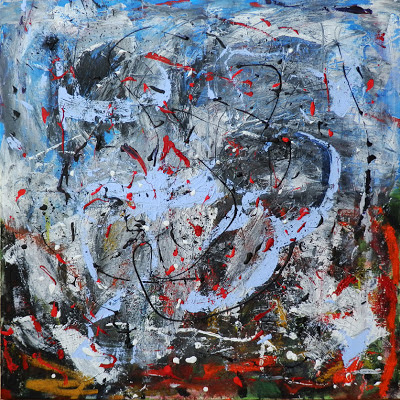Black
Black
Black
Black
David Abse: Paintings and stuff. Regular updates regarding new work, exhibitions and other art-related stuff of interest.
 |
| Pomegranates Oil on canvas 60x50cm £550/650€/820$ |
 |
| Self Portrait 2013 |
 |
| Self Portrait 1984 |
 |
| Man with hat Oil on Canvas, 55x46cm 500€/£600/$750 |
 |
| Here we go again100x100cm, Acrylic on canvas £1,000/1 200€/$1,500 |
 |
| Marley 40x40cm Oil on Canvas |
 |
| Cats and Gods Oil on canvas, 40x40cm £400/480€/$600 |
 |
| Dannie Abse 66x33cm, oil on canvas |
 |
| Summer Dreams mixed media on canvas 165x114cm |
 |
| Inscrutable Acrylic on Paper 50x66cm £170/200€/$250 |
 |
| The Wisdom of Cats Mixed Media on Canvas 60x72 |
 |
| Street Life Acrylics on canvas 60x72cm |
 |
| Difficult Fun Mixed Media on paper 50x66cm |
 This guy used similar symbols to me - we'd both done the same internet research. His colours were based on the Moroccan flag. He was second to finish.
This guy used similar symbols to me - we'd both done the same internet research. His colours were based on the Moroccan flag. He was second to finish. This woman painting below looked like she might not finish in time. There was only about 30 minutes left at this point.
This woman painting below looked like she might not finish in time. There was only about 30 minutes left at this point. |
| Moroccan Window 4 100x100cm, Acrylic on canvas |
 |
| Moroccan colours 100x100cm Acrylic on Paper |
 |
| Moroccan Window 100x100cm, Acrylic on canvas |
Ryle's The Concept of Mind (1949) is a critique of the notion that the mind is distinct from the body, and a rejection of the theory that mental states are separable from physical states. In this book Ryle refers to the idea of a fundamental distinction between mind and matter as "the ghost in the machine." According to Ryle, the classical theory of mind, or "Cartesian rationalism", makes a basic "category-mistake", because it attempts to analyze the relation between "mind" and "body" as if they were terms of the same logical category. This confusion of logical categories may be seen in other theories of the relation between mind and matter. For example, the idealist theory of mind makes a basic category-mistake by attempting to reduce physical reality to the same status as mental reality, while the materialist theory of mind makes a basic category-mistake by attempting to reduce mental reality to the same status as physical reality of a special kind. It is, namely, a category mistake.Arthur Koestler then wrote a book taking Ryle's ideas: "The Ghost in the Machine". Again from Wikipedia:
The Ghost in the Machine is a non-fiction work in philosophical psychology written by Arthur Koestler and published in 1967. The title is a phrase coined by the Oxford philosopher Gilbert Ryle to describe the Cartesian dualist account of the mind–body relationship. Koestler shares with Ryle the view that the mind of a person is not an independent non-material entity, temporarily inhabiting and governing the body. One of the book's central concepts is that as the human brain evolved, it retained and built upon earlier, more primitive brain structures. The work attempts to explain humanity's tendency towards self-destruction in terms of brain structure, philosophies, and its overarching, cyclical political–historical dynamics, reaching the height of its potential in the nuclear arms arena.But the concept of dualism has been widely exploited in art - by musicians, writers and artists. It is hard to equate thought/emotion/idea as the (mere?) product of a physical act. Some wires buzzing in your head. And as I have noted here and elsewhere, sometimes it can be hard to equate the fact there is only ONE mind in (working?) your body. And then there's the sub-conscious...
 |
| The Ghost in the Machine Mixed media on canvas 80x54cm |
 |
| Disequilibrium - 100x100cm, mixed media on canvas |
 |
| Moroccan Window |
 |
| Franz Kline - Mahoning, 1956. Oil and paper collage on canvas. 80 x 100 in. (203.2 x 254 cm) |
 |
| David Abse - Cat and Bird, 2013. Acrylic on board 72x54cm. |
 |
| David Abse - Head, 2013. Mixed media on wood, 80x60cm |